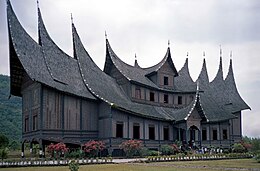
| Part of a series on the |
| Culture of Indonesia |
|---|
 |
| People |
| Languages |
| Mythology and folklore |
| Cuisine |
| Literature |
| Music and performing arts |
| Sport |
The architecture of Indonesia reflects the diversity of cultural, historical, and geographic influences that have shaped Indonesia as a whole. Invaders, colonizers, missionaries, merchants, and traders brought cultural changes that had a profound effect on building styles and techniques.
Numbers of Indonesian vernacular houses have been developed throughout the archipelago. The traditional houses and settlements of the several hundred ethnic groups of Indonesia are extremely varied and all have their specific history. The houses hold social significance in society and demonstrate local ingenuity in their relations to the environment and spatial organisation.[1]: 5
Traditionally, the most significant foreign influence has been India. However, Chinese, Arab, and European influences have also played significant roles in shaping Indonesian architecture. Religious architecture varies from indigenous forms to mosques, temples, and churches. The sultans and other rulers built palaces. There is a substantial legacy of colonial architecture in Indonesian cities. Independent Indonesia has seen the development of new paradigms for postmodern and contemporary architecture.
- ^ Reimar Schefold; P. Nas; Gaudenz Domenig, eds. (2004). Indonesian Houses: Tradition and Transformation in Vernacular Architecture. NUS Press. ISBN 9789971692926.